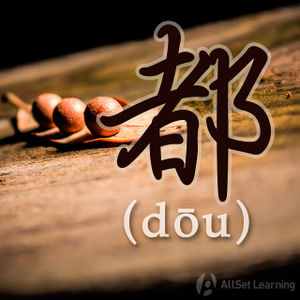Difference between revisions of "The "all" adverb "dou""
m (Text replacement - "xǐhuān" to "xǐhuan") |
|||
| Line 1: | Line 1: | ||
{{Grammar Box}} | {{Grammar Box}} | ||
| − | The adverb 都 (dōu) is used to express "all" in Chinese. It's | + | The adverb 都 (dōu) is used to express "all" in Chinese. It's common to use 都 (dōu) in a variety of sentences where it would seem unnecessary in English. |
== 都 for "all" == | == 都 for "all" == | ||
| Line 29: | Line 29: | ||
== 都 for "both" == | == 都 for "both" == | ||
| − | Chinese doesn't normally use a special word for "both" like English does. It just uses 都 (dōu) as if it were any other number greater than one. Chinese also doesn't have a special pattern like "neither / nor" for the negative case. Just use 都 (dōu) and make the sentence negative. | + | Chinese doesn't normally use a special word for "both" like English does. It just uses 都 (dōu) as if it were any other number greater than one. Chinese also doesn't have a special pattern like "neither / nor" for the negative case. Just use 都 (dōu) and make the sentence negative. |
=== Structure === | === Structure === | ||
Revision as of 02:32, 15 March 2016
-
Level
-
Similar to
-
Used for
-
Keywords
The adverb 都 (dōu) is used to express "all" in Chinese. It's common to use 都 (dōu) in a variety of sentences where it would seem unnecessary in English.
Contents
都 for "all"
Structure
Subject + 都 + [Verb Phrase]
Remember that 都 (dōu) appears after the subject. A common mistake learners make is to put 都 (dōu) at the beginning of the sentence (as "all" often appears there in English). This isn't good Chinese - make sure you put 都 (dōu) after the subject and before the verb.
Examples
- 你们 都 认识 John 吗 ? Do you all know John?
- 他们 都 在 上海 。 They are all in Shanghai.
- 明天 我们 都 可以 去 。 Tomorrow we all can go.
- 你们 都 用 wiki 吗 ? Do you all use the wiki?
- 我们 都 要 冰水。 We all want ice water.
都 for "both"
Chinese doesn't normally use a special word for "both" like English does. It just uses 都 (dōu) as if it were any other number greater than one. Chinese also doesn't have a special pattern like "neither / nor" for the negative case. Just use 都 (dōu) and make the sentence negative.
Structure
Subjects + 都 + [Verb Phrase]
This pattern should look familiar.
Examples
These examples follow exactly the same form in Chinese as the ones above. The only difference is that here we don't translate 都 (dōu) as "all" in English; we translate it as "both," and for negative cases, we translate it as "neither."
- 我们 两 个 都 爱 你 。 The two of us both love you.
- 你 爸爸 和 你 妈妈 都 是 美国人 吗? Are your father and your mother both Americans?
- 我 和 我 太太 都 不 吃 肉。 Neither my wife nor I eat meat.
- 你们 两个 都 喜欢 中国 菜 吗? Do you both like Chinese food?
- 她 和 她 老公 都 没有 工作。 Neither she nor her husband has a job.



